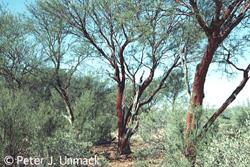|
Desert: Plants
Short grasses,
sagebrush, creosote bushes, and cacti are just a few of the plants
that can be found in the desert. Plant abundance and variety are
determined by the geographic location of the desert. Although short
grasses can be found in nearly all desert locations, the saguaro
cactus is unique to the Sonoran Desert, and the spiniflex is associated
with the Australian Desert.
 Plant
adaptations Plant
adaptations
Because of the dry climate, plants have developed a number of different
methods of capturing water. Some plants have developed long (20-30
foot) taproots that go deep into the ground and tap into groundwater
sources. Other plants have developed extensive horizontal root systems.
These horizontal root systems lie just below the surface and extend
far beyond the plant canopy. When it rains the numerous tiny roots
capture the water. The mulga tree's root system lies close to the
base of the tree. The tree survives because it has developed its
own unique system of collecting water. The tree's numerous tiny
leaves grow upward. When it rains the leaves capture the water and
funnel it down along the branches to the center of the tree. The
water then falls to the ground near the trunk of the tree where
tree roots are concentrated. Photo
courtesy of Peter J. Unmack, at
www.utexas.edu/depts/tnhc/.www/fish/dfc/australi
Another common physical
adaptation is the ability of desert plants to store water in their
roots, stems, leaves, or fruit. Plants that store water in this
way are referred to as succulents, and they include cacti.
Desert plants retain
moisture by limiting water loss through their leaf surface. Many
plants accomplish this by adapting the size, sheen, or texture of
their leaves. Small leaves or spines limit the amount of surface
area exposed to the drying heat. Glossy leaves reflect the Sun's
radiant heat reducing leaf temperatures and evaporation rates. Waxy
leaves prevent moisture from escaping. Water escapes from leaves
through the stomata, or leaf pores. A behavioral adaptation used
by some plants is to only open leaf pores during the night when
air temperature is cool and evaporation rate is low.
Back
| Next
|











